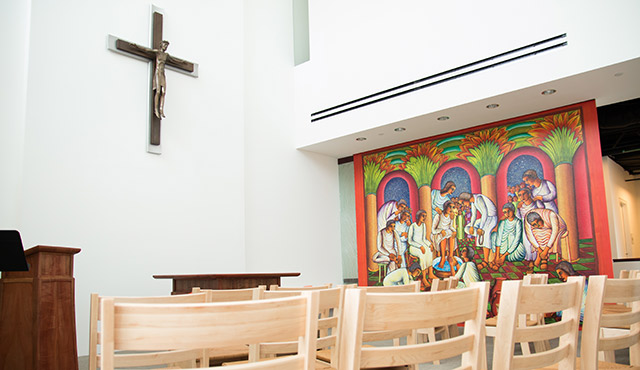When Bishop Kevin Vann offered a blessing of dedication for the new Chapel of Unity and Reconciliation at the Cultural Center on the Christ Cathedral campus July 19, he underscored the vibrant charism of one of the most visible orders of religious women in the country: the Sisters of St. Joseph of Orange.
The chapel honors the sisters, who have lived and worked in Orange County since 1922, educating children, offering job skills training, teaching the deaf, advocating for social justice, and healing the sick. The chapel project was funded by a contribution from St. Joseph Health, which the sisters founded in 1920.
In the Beginning
The story of the order actually begins centuries ago. “The Sisters were started in 1650 by a Jesuit named Jean Pierre Medaille, who gathered a group of women in the small town of Le Puy, France,” explains Sister Katherine “Kit” Gray, CSJ, Director of Mission Integration and Ongoing Formation at Christ Cathedral.
The contemporary social climate was filled with divisions and feuds all around, and Father Medaille urged the sisters to work for reconciliation—and this has been the No. 1 charism for the order ever since.
“That’s the driver for us,” says Sister Kit. “We can do almost anything for that mission of bringing people together and bringing them to God.”
The sisters travelled to America and first settled in Northern California, where they cared for victims of the 1918 flu epidemic and opened a hospital. They came to Orange County in 1922 and opened another 90-bed hospital in Orange, St. Joseph Hospital. In 1931, they bought Fullerton General Hospital then later closed it and raised funds for St. Jude Medical Center, which opened in 1957.
Today St. Joseph Health is a major health care system of 14 hospitals, but the ministry of the sisters goes beyond health care. They’ve established the Pilgrimage Psychotherapy Center, Casita de San Jose to care for foster children, job placement program Taller San Jose, a Santa Ana children’s dance program now called the Wooden Floor, and many other ministries.
Choices for the Chapel
Creating the chapel in a way that reflects the mission of the sisters took two years, and naturally includes a statue of Saint Joseph. “As Sisters of St. Joseph, we wanted a place where all could come together as a community, seeing and praying with each other,” says Sister Mary Therese Sweeney, CSJ, a board member of St. Joseph Health who was part of the planning committee. “We value simplicity. Our depiction of Joseph is of a simple working man who openheartedly welcomes all.”
Careful consideration was given to the artwork chosen for the chapel. “At the 1650 founding of the Sisters of St. Joseph, the language of ‘deserving poor’ was coming into use to separate the more sympathetic or attractive poor from those who could be excluded with a clearer conscience,” explains Sister Mary Therese. “For the sisters, there were only neighbors without distinction. John August Swanson’s ‘Washing of the Feet’ mural perfectly depicted the message of reconciliation that we wanted to emphasize.”
Artist Alexander Tylevich was selected to create the bronze statue of Saint Joseph, as well as a crucifix for the space.
“From the beginning, Tylevich’s art and his underlying theology of the crucifixion attracted us, and he was the only artist we ultimately wanted,” says Sister Mary Theresa. Even the wood used in the chapel was carefully chosen. “We wanted wood from Humboldt County and a craftsman from there to honor the congregational roots in Northern California,” she says. “Joel McCoy has the artistic skill to bring out the character and integrity of wood.”
“This beautiful space will serve as a fitting reminder to all who visit Christ Cathedral of the profound love of God shared with millions through the ministries of the Sisters of St. Joseph of Orange,” says Bishop Vann.

